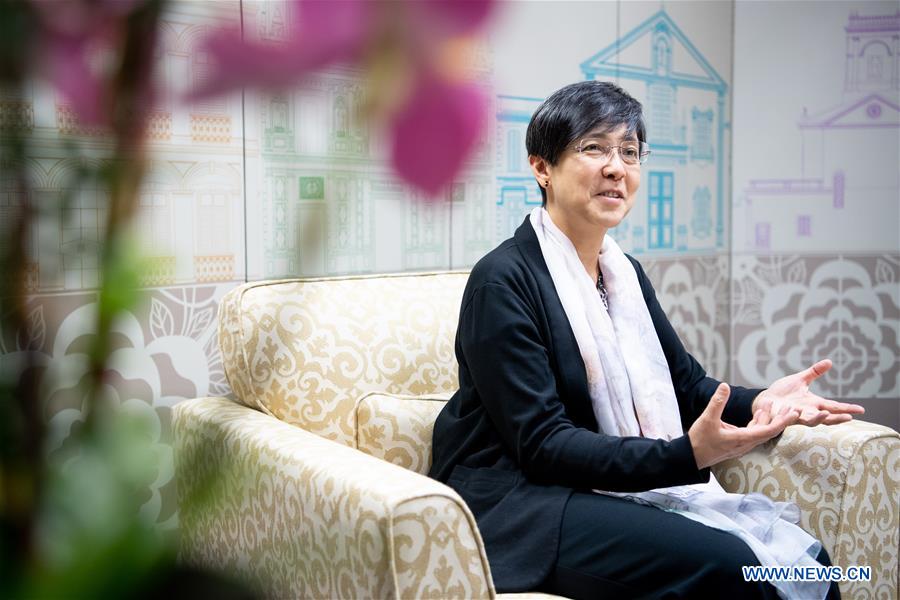
Maria Helena de Senna Fernandes, the chief of Macao Government Tourism Office, reacts during an interview in south China's Macao, Oct. 31, 2019. (Xinhua/Liu Jinhai)
by Xinhua writers Wang Chenxi, Cao Bing
MACAO, Dec. 10 (Xinhua) -- Macao had welcomed over 33 million visitors in the first 10 months of 2019, said a latest report from Macao Statistics and Census Service.
The tourism industry anticipates that Macao will receive 40 million visitor by the end of 2019.
Before returning to the motherland, Macao had about 7 million visitors in 1999. In 2018, some 35.8 million visitors came to this special administrative region (SAR), which covers an area of about 33 square km and hosts a population of 670,000.
Maria Helena de Senna Fernandes, the chief of Macao Government Tourism Office, told Xinhua reporters that Macao's booming tourism industry has been promoted by the rapid development of the mainland and preferential policies from the central government.
In 2003, mainland residents were allowed to visit Macao by personal application. In 2008, the outline of the reform and development plan for the Pearl River delta region proposed for the first time the position of Macao as a world tourism and leisure center.
China's 12th and 13th Five-Year Plans also had set forth the major measures to support Macao's development and make it a world center of tourism and leisure.
In 2015, the central government granted the Macao administrative authority for 85 square km of its surrounding sea, giving it an opportunity for marine tourism.
The Outline Development Plan for the Guangdong-Hong Kong-Macao Greater Bay Area published in 2019 reiterated the support for Macao's tourism and leisure industry.
The inflow of tourists and supportive policies have worked together to expand the tourism market. In 1999 there were only about 9,000 hotel rooms in Macao. Now Macao's hotel room number has reached 40,000, with an average occupancy of over 90 percent, according to the tourism office.
Macao has a unique festival culture, including traditional Chinese festivals such as the Lunar New Year and Dragon Boat Festival, as well as Western festivals such as Easter and Christmas.
In addition, Macao holds events such as Grand Prix, art festival, international music festival, fireworks festival, food festival and International film festival every year. Those traditional and modern events all add up to Macao's attraction to visitors, gaining more recognition from international organizations.
In 2005, Macao's historic districts had been enlisted into World Cultural Heritage. The Ruins of Saint Paul's has become an icon of Macao to the world.
In 2017, Macao was accepted as a new member of UNESCO Creative Cities Network in the field of gastronomy.
World Tourism Organization's latest statistics showed that Macao had tourism revenue of 40.2 billion U.S. dollars in 2018, ranking the fifth in the Asia and Pacific region, or the 11th in the world.
The chief of Macao Government Tourism Office said the industry had never focused on quantity. "We have made a lot of efforts in upgrading our service quality and visiting experience," she added.
The tourism office launched the Quality Tourism Services Accreditation Scheme in 2014 to encourage and support the travel agencies, food and cattery industry, and retailers to enhance service quality.
In 2017, the Macao SAR government issued the Macao Tourism Industry Development Master Plan and set out a blueprint for Macao's tourism development in the next 15 years.
"The purpose of our effort is not only to make Macao a successful tourism destination, but also a place of quality life and work for its residents," the tourism chief added.
Besides the infrastructure and activities, Macao also has raised the awareness of tourism among the residents to understand its importance and close relation to their life.
The tourism office has initiated Macao Tourism Awareness Campaign since 2013 and attracted 130,000 residents to participate.
The booming tourism has promoted the tourism education and training in Macao, which also support the industry development in return. The major universities in Macao have classes or programs related to tourism education.
The Macao Institute for Tourism Studies, for example, has over 1,600 undergraduates in 2019, and more than 20,000 have taken its adult education programs. Back in 1995 when the institute had its first class, it only had 60 undergraduates and about 1,000 adult education students.
In 2019 Academic Ranking of World Universities' Global Ranking of Academic Subjects, the Macao Institute for Tourism Studies took the 5th place in Asia and the 30th globally in terms of the subject Hospitality and Tourism Management.
The Outline Development Plan for the Guangdong-Hong Kong-Macao Greater Bay Area mentioned that Macao is set to build a tourism education and training base, improve the quality of tourism professionals of the Greater Bay Area and thus promote the region's tourism development.



